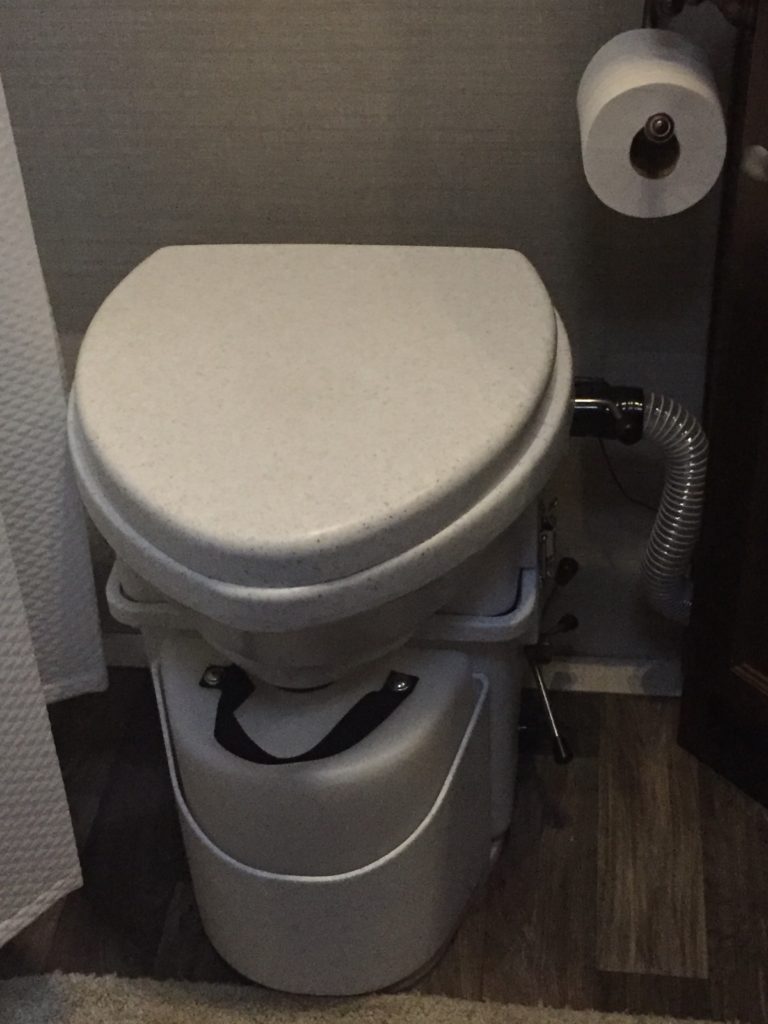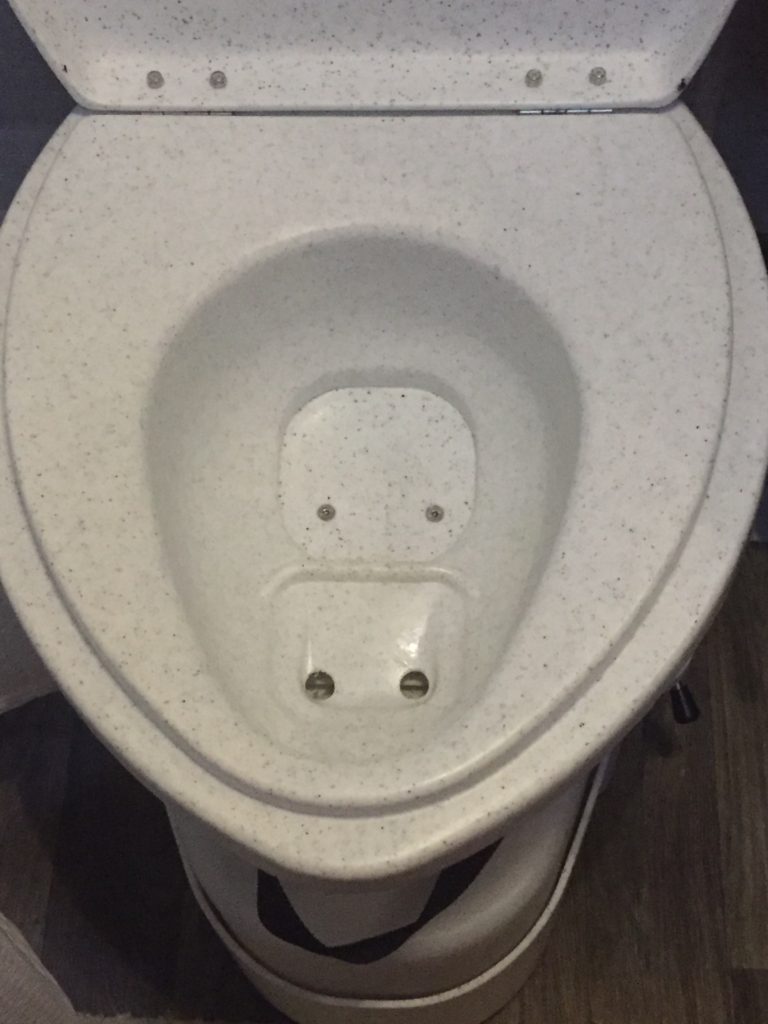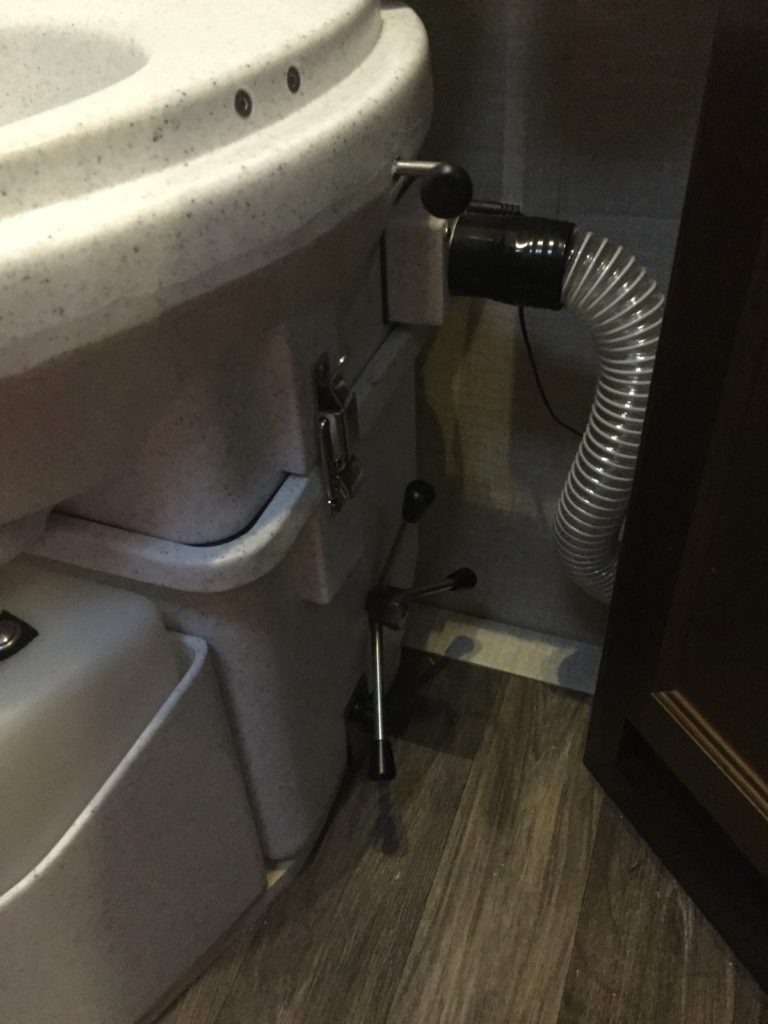
When I first began researching what would be involved with traveling in an RV, one of my foremost concerns was dealing with the black (sewage) tank. That’s right. I was less worried about towing, leaks, or any of the other things that REAL rv-ers spend their energy thinking about. I was concerned about that awful black tank where all the toilet “products” are flushed. The thought of driving to dumps to flush out my own waste just sounded horrendous and I wanted to figure out a way to bypass that.
Another issue with a regular RV toilet and black tank system is that each flush uses around 1-3 gallons of fresh water. If you end up flushing 2-3 times a day, that means you can very quickly diminish your fresh water supply. For someone who really wanted the freedom of dry camping (that is, being able to stay in places with no water, electric, or sewage hookups), the toilet alone can really limit the amount of time you get to spend somewhere without having to drive to town to dump the black and grey tanks and replenish the fresh water tank.
During my research on RV toilet alternative, I began learning about composting toilets. What is a composting toilet, you ask? Well… it’s a self-contained toilet that uses no water. It’s sort of like a port-a-potty, but it separates out #1 and #2, thus preventing the creation of sewage. Sewage is where that god-awful stench comes from. When separated, urine and solid waste don’t have that terrible odor. Don’t get me wrong, it’s not Chanel No. 5, nor does it ramp up my appetite for dinner, but it’s not intensely offensive.

In my composting toilet, urine is filtered into a front holding tank that I have to dump every 2-3 days (more on that, later), and solid waste goes to a large tank, where it is mixed with composting material, such as peat moss or coconut fiber. The solid waste tank is vented to keep adequate oxygen movement in order to create compost from your, well, shit. As a result, the perfect amount of oxygen is supposed to circulate in the waste tank (when you do it right…more on that later, too) to keep the bacteria aerobic, and limit the amount of odor that is produced. It’s also important to make sure you prep the toilet with enough composting material (trust me on this) – when you don’t use enough, there’s too much moisture, bacteria go anaerobic, and an odor develops.
The benefits of a composting toilet are pretty obvious: 1) no black tank to dump, and 2) no wasting your fresh water to flush. But there…are…cons. After a month of using a Nature’s Head (clever, eh?) composting toilet, I have experienced the cons. I know this is the part you’ve been waiting for – so I give you…
Lessons from my first month of using a waterless shitter…
- The pee tank will overflow. This makes sense, right? Just like overpouring a glass of water, your pee tank will overflow if you don’t empty when it’s full. One evening, a couple of weeks ago, I glanced at the urine container and thought “I need to empty that.” Then I thought, “I’ll do it later,” and had a couple glasses of wine. Well, you know, the wine worked double duty: It made me have to pee, and it made me forget I could not fit any more pee into my pee jug (I wonder, how many times can I use the word “pee” in one paragraph?). Midstream, I remembered. But it was too late. When I opened the toilet to remove the urine canister, the excess poured out onto my floor. As so for the first time in my life, I had to clean my own piss off the floor.
- The right moisture level is key to keeping the solid waste tank from smelling. In my set-up, the vent tube from the toilet flows out to the roof on the rear of the trailer. About two weeks ago, I began to notice a slight odor on occasion, when I walked to the rear of the trailer. It didn’t smell like sewage, because there was none, but it smelled…suspect. And suspect, when dealing with human waste, is never good. I knew it had to be from the toilet but couldn’t figure out why. In all these YouTube videos I had watched, people praised the compost toilets. “It really doesn’t smell!” they would exclaim (and then direct their viewers to the Amazon affiliate link in the video’s description box so you could purchase your own -by the way, they cost $1k). Mine didn’t smell in the trailer, but there was something funky coming from the vent tube. Yesterday, before I dumped the solid waste tank… I figured out the problem. I hadn’t used enough composting material (coconut fiber), which resulted in too much moisture in the tank, so the bacteria went anaerobic and began creating that…smell.

Needless to say, the realization that my waste tank probably looked more like crap and less like “potting soil,” as those liars in the YouTube videos claimed it would, reduced my excitement level when it came to emptying it. However, the process of dumping it wasn’t bad at all. I took the toilet apart, put a garbage bag over the top of it, carried it outside, turned it over, and dumped. I double-bagged it, carried it to the dumpster (which is totally legal, by the way), and threw it away. It was heavier than I expected (not sure why this surprised me -maybe because I’ve never had to transport a garbage bag of my own crap before??).
After realizing I had not used enough composting material the first time, I prepped the toilet with extra this time around.
What are my final thoughts on the toilet? I think it was a solid decision (see what I did there?). The biggest pain in the ass (help! I can’t stop!) is having to empty the urine container, but I’d rather do that every couple days and not have to deal with dumping a black tank that depletes my fresh water supply. I think dealing with a composting toilet is gross, period. Anyone who says otherwise is lying. However, for one person, the solid tank only needs to be emptied about every two months or so – which is far less frequent than a black tank would need dumped. At the end of the day, the compost toilet aligns with my goals for traveling, so I give it a thumb’s up (I do, however, think the price tag is a bit hefty).
One Response